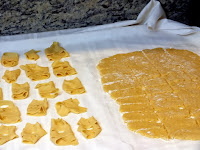These are two of the typical fritters made during carnival time in Italy!!!! I have slightly revised the recipe I sent about a year ago (after all this is carnival period ;-) ), in order to be a little easier. You can make the thinner ones (crostoli) with the pasta roller or the rolling pin; if you use the pin, they'll be a little thicker, actually. Quantities are in grams and US quantities are approximate, if you can, please buy a cheap digital scale :-). The video is the old one, so please, watch it considering the preparation and not the quantities for ingredients. Some of the changes will be noted in the footnotes.
(crostoli) (crogetti)
For crostoli:
150 gr. 00 Italian flour (1 1/4 cups)
1 large eggs
1 tbsp Italian extra virgin olive oil
1 tbsp Italian white wine vinegar
1 tbsp sugar
1 tbsp grappa
1 large eggs
1 tbsp Italian extra virgin olive oil
1 tbsp Italian white wine vinegar
1 tbsp sugar
1 tbsp grappa
For crogetti:
275 gr. 00 Italian flour (2 cups)
130 gr. sugar (3/4 cup)
2 large eggs
2 tsp baking powder
2/3 shot glass of vin santo (limoncello in the photo used last time, brandy used this time)
grated lemon zest (1 lemon)
Italian extra virgin olive oil to fry
confectioner's sugar
1 Start working on the crogetti.
In a bowl, quickly mix flour (sifted with baking powder), sugar and lemon zest, then add eggs and vin santo. Mix a little more to minimize the "mess".
Transfer on a floured surface and knead until you obtain a smooth dough: it will be really sticky, so keep your hands and surface floured.
Wrap in FLOURED plastic wrap and let it rest for about 30 minutes in the refrigerator.
2 In the meantime, get your crostoli started.
Mix sifted flour and sugar in a bowl, then create a well and add eggs, oil, vinegar and grappa; mix all ingredients then transfer onto a surface and knead until you obtain a smooth dough.
Wrap in plastic and let rest for 30 minutes.
3 Remove crogetti dough from the refrigerator and roll it with a rolling pin to about 1/4" thick. Do this onto floured plastic wrap (you can check my video to see how I do it), always dusting with flour so the pin won't stick too much.
Dust with flour again and cover with some more wrap. Set aside, until ready to fry.
4 Get back to crostoli
Roll out as thin as possible, if you use a pasta machine, go to the thinnest possible.
Cut dough in squares, make three cuts in the squares and have sides fold into the external cuts.
(ready to fry)
5 Warm up olive oil in a deep saucepan and fry them.
Crogetti will puff up in the oil, thanks to the baking powder. Turn them once or twice, to get them golden on both sides. Try not to have your oil too hot or they won't cook inside without burning the outside.
Crostoli, being very thin, it won't take long, flip them once or twice in order to become golden on both sides. I usually start with crogetti, but you can do as you please.
Transfer them on paper towel to absorb excess oil, then arrange on a platter and sprinkle with confectioner's sugar.
These quantities will make about 40/50 pieces each, depending on thickness and size.
- Originally crostoli should have 1 egg per 200 gr flour but I always have problems kneading the dough. If you still feel it too dry to knead, add 1 extra tbsp of grappa and/or vinegar.
- Vinegar will NOT be tasted, it will only give more crispness.
- The thinner you roll crogetti out, the faster the frying will be (absorbing even less oil).
- Don't keep your crogetti too thick or they may not cook completely.
- They are both lactose free and vegetarian.
- If you are interested in Crogetti only, follow steps 1-3-5; if you are interested in Crostoli only, follow steps 2-4-5
- You can find a video for this recipe here (please note the info in the introduction of the recipe)










Nessun commento:
Posta un commento